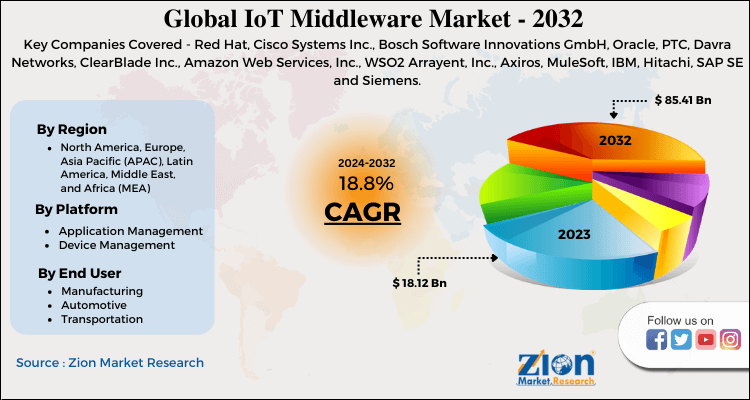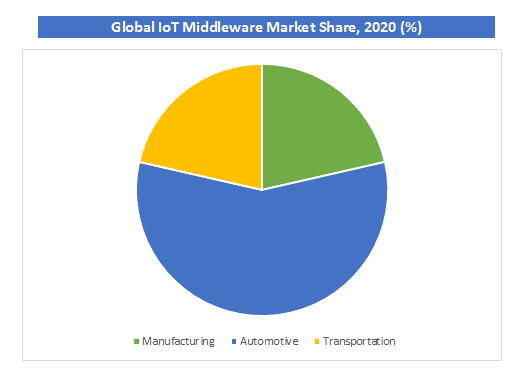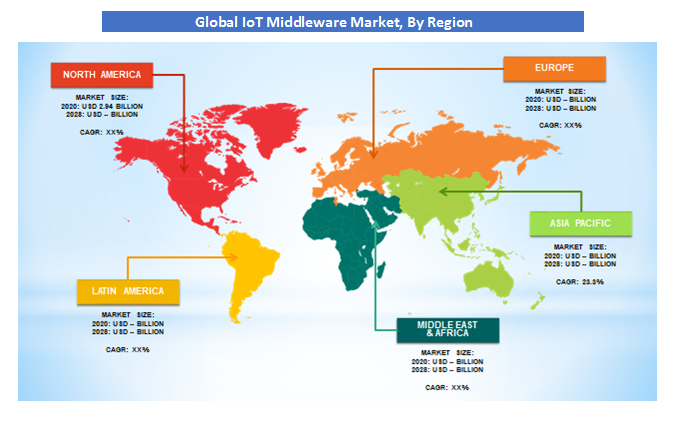IoT Middleware Market Size, Share, Growth, And Forecast 2032

IoT Middleware Market By Platform (Application Management, Device Management and others), By End User (Manufacturing, Automotive and transportation and others), and By Region - Global and Regional Industry Overview, Comprehensive Analysis, Historical Data, and Forecasts 2024-2032
| Market Size in 2023 | Market Forecast in 2032 | CAGR (in %) | Base Year |
|---|---|---|---|
| USD 18.12 Billion | USD 85.41 Billion | 18.8% | 2023 |
IoT Middleware Market Size
According to Zion Market Research, the global IoT Middleware Market was worth USD 18.12 Billion in 2023. The market is forecast to reach USD 85.41 Billion by 2032, growing at a compound annual growth rate (CAGR) of 18.8% during the forecast period 2024-2032.
The report offers a comprehensive analysis of the market, highlighting the factors that will determine growth, potential challenges, and opportunities that could emerge in the IoT Middleware Market industry over the next decade.
IoT Middleware Market: Overview
IoT (Internet of Things) middleware software acts as an interface between the components of IoT, thus making communication possible among the elements. Middleware is used to connect complex and already existing programs that were originally not designed to be connected. The market is primarily driven by the increasing adoption of cloud models by enterprises, governments, and private organizations to optimize the operational capabilities of traditional devices. Many SMEs and large enterprises nowadays have been inclining towards achieving higher efficiency using lower costs, thus making the use of IoT platforms to increase the scalability and efficiency of the business process. Also, IoT platforms have a complex architecture as a large number of devices are connected to the network that sends data to the cloud.
COVID-19 Impact Analysis
The global impacts of COVID-19 are estimated to positively affect the IoT Middleware market in 2021. With the outbreak of COVID19, there have increasing social distancing norms that have been implemented in various countries. In the case of the IoT Middleware market, the IoT hardware and sensors are supplied from China due to their low costs. But due to COVID-19, the majority of the countries have cut off their all imports. Due to the decline in the supply of sensors and connectivity hardware, the growth of IoT will be affected negatively. Also, many countries have reduced imports from China, leading to a rise in the price of IoT hardware. Thus the market has been affected negatively due to the pandemic.
IoT Middleware Market: Growth Factors
The growing adoption of cloud models by the government and private enterprises is the major factor driving the market. There has been an increase in spending on goods and services that involve IoT components. Also, there are government initiatives such as smart cities development which is the factor fueling the demand for IoT middleware market. The growing trend of smart homes, factories, and connected buildings are creating demand for the IoT middleware market. There have also been significant partnerships among the vendors to innovate advanced middleware software.
The increase in regulatory compliance and the evolution of high-speed network technologies are also factors contributing to the overall growth of the market. The increasing trend of centralized monitoring and the evolution of high network technologies are the factors fueling the demand for the IoT middleware market. Also, in the manufacturing sector, there has been increasing demand as IoT enables manufacturers to connect machinery and control systems together.
Platform Analysis Preview
Organizations are readily adopting IoT middleware for device management applications as it acts as an agent between the service providers (IoT devices) and service consumers (enterprise applications). It acts as a mediator interface between the Internet and ‘things’. As this middleware provides the solutions such as interoperability, dependability, and security, they are in high demand in the market. In device management, middleware hides many complexities and architectural details from both application and object sides, in order to communicate with minimum knowledge. Thus, IoT middleware is in great demand for device management applications.
End User Analysis Preview
This is due to the fact that IoT middleware can implement IoT-based virtual manufacturing applications and also IoT-based factory automation, which has been encouraging manufacturers to deploy IoT in key manufacturing processes. The growing acceptance of Industry 4.0 and the Internet of Things (IoT) is also an important factor in the demand for IoT middleware in the Manufacturing sector. Also, the advantage of IoT in attaining informed manufacturing is the factor fueling the demand for the IoT middleware market.
IoT Middleware Market: Report Scope
| Report Attributes | Report Details |
|---|---|
| Report Name | IoT Middleware Market |
| Market Size in 2023 | USD 18.12 Billion |
| Market Forecast in 2032 | USD 85.41 Billion |
| Growth Rate | CAGR of 18.8% |
| Number of Pages | 140 |
| Key Companies Covered | Red Hat, Cisco Systems Inc., Bosch Software Innovations GmbH, Oracle, PTC, Davra Networks, ClearBlade Inc., Amazon Web Services, Inc., WSO2 Arrayent, Inc., Axiros, MuleSoft, IBM, Hitachi, SAP SE and Siemens |
| Segments Covered | By Platform, By End User and By Region |
| Regions Covered | North America, Europe, Asia Pacific (APAC), Latin America, Middle East, and Africa (MEA) |
| Base Year | 2023 |
| Historical Year | 2018 to 2022 |
| Forecast Year | 2024 - 2032 |
| Customization Scope | Avail customized purchase options to meet your exact research needs. Request For Customization |
IoT Middleware Market: Regional Analysis Preview
North America held a share of 38% in 2020. It is supposed to be one of the highest revenue-generating regions for this market during the forecasted period. This high growth is due to the factors such as the growing role of IoT in the end-user industries of the region, deployment of smart energy projects, growing trends of connected cars, home automation, and increasing focus on smart manufacturing. Another important factor for the growth of IoT middleware is increasing input cost of labor and growing competition from large manufacturers which is attracting the demand for the IoT devices and hence the IoT middleware too. As the US is on the verge of the fourth industrial revolution, data is being used on a large scale of production integrating a wide range of manufacturing systems. Thus, this increases the overall demand for the market.
Asia-Pacific is expected to have a CAGR of 23.3% from 2024 to 2032. This is due to the fact that there has been significant demand for IoT in connecting devices to establish a connection between other devices. The technological advancement in smartphones along with a rising number of smartphone users has further boosted the demand for the market. The growing demand for IoT connectivity in the government initiatives such as smart cities has further fueled the growth of the IoT middleware market in this region.
IoT Middleware Market: Key Players & Competitive Landscape
Some of the key players in the IoT Middleware market include:
- Red Hat
- Cisco Systems Inc.
- Bosch Software Innovations GmbH
- Oracle
- PTC
- Davra Networks
- ClearBlade Inc.
- Amazon Web Services Inc.
- WSO2 Arrayent Inc.
- Axiros
- MuleSoft
- IBM
- Hitachi
- SAP SE
- Siemens
In March 2020, Kerlink which is the provider of solutions dedicated to the Internet of Things (IoT), and Zenner IoT solutions GmbH which is a LoRaWAN system integrator, collaborated on the massive LoRaWAN network for Energy, Gas, and Water Company. The overall network is operated by Netze BW, which is the largest distribution network for electricity, gas, and water.
The Global IoT Middleware Market is segmented as follows:
By Platform
- Application Management
- Device Management
By End User
- Manufacturing
- Automotive
- Transportation
By Region
- North America
- The U.S.
- Canada
- Europe
- France
- The UK
- Spain
- Germany
- Italy
- Rest of Europe
- Asia Pacific
- China
- Japan
- India
- South Korea
- Southeast Asia
- Rest of Asia Pacific
- Latin America
- Brazil
- Mexico
- Rest of Latin America
- Middle East & Africa
- GCC
- South Africa
- Rest of the Middle East & Africa
Table Of Content
Methodology
FrequentlyAsked Questions
IoT middleware is a software layer that connects Internet of Things (IoT) devices to applications and other systems, enabling seamless communication, data management, and integration.
According to study, the IoT Middleware Market size was worth around USD 18.12 billion in 2023 and is predicted to grow to around USD 85.41 billion by 2032.
The CAGR value of IoT Middleware Market is expected to be around 18.8% during 2024-2032.
North America has been leading the IoT Middleware Market and is anticipated to continue on the dominant position in the years to come.
The IoT Middleware Market is led by players like Red Hat, Cisco Systems Inc., Bosch Software Innovations GmbH, Oracle, PTC, Davra Networks, ClearBlade Inc., Amazon Web Services Inc., WSO2 Arrayent Inc., Axiros, MuleSoft, IBM, Hitachi, SAP SE, and Siemens.
RelatedNews
HappyClients
Zion Market Research
Tel: +1 (302) 444-0166
USA/Canada Toll Free No.+1 (855) 465-4651
3rd Floor,
Mrunal Paradise, Opp Maharaja Hotel,
Pimple Gurav, Pune 411061,
Maharashtra, India
Phone No +91 7768 006 007, +91 7768 006 008
US OFFICE NO +1 (302) 444-0166
US/CAN TOLL FREE +1 (855) 465-4651
Email: sales@zionmarketresearch.com
We have secured system to process your transaction.
Our support available to help you 24 hours a day, five days a week.
Monday - Friday: 9AM - 6PM
Saturday - Sunday: Closed









